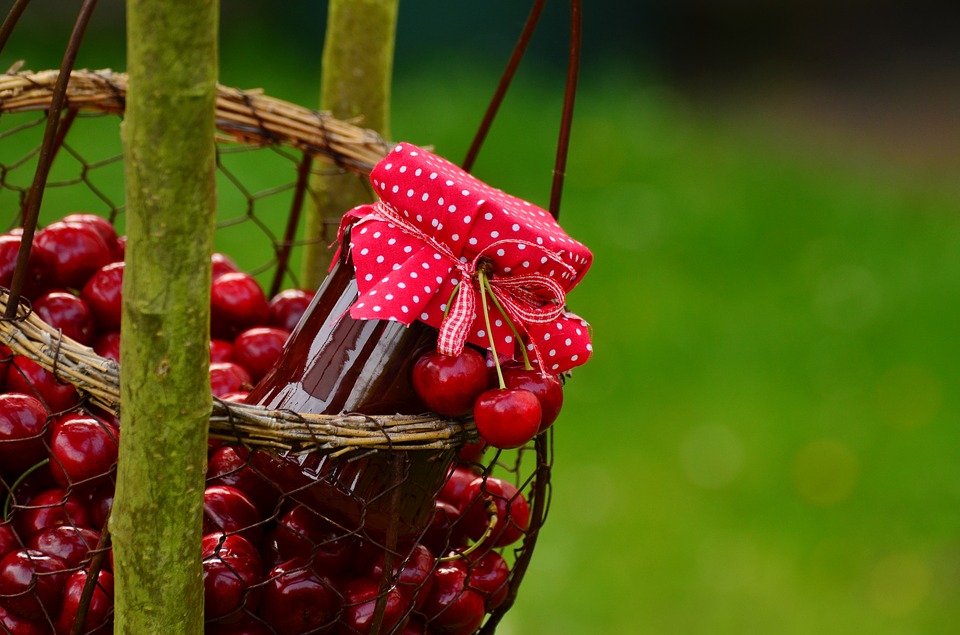Cherries, with their vibrant colours and sweet flavour, are a beloved summer treat for many humans. But can our canine companions share in this delightful indulgence? The answer, unfortunately, is not a simple yes or no. While the juicy flesh of a cherry might seem harmless, the seeds and other parts of the cherry plant contain a potentially toxic compound called cyanide. This guide will equip you with the knowledge you need to make informed decisions about cherry consumption for your furry friend.
Part 1: The Nutritional Value of Cherries

Cherries are a nutritional powerhouse, boasting an impressive array of vitamins, minerals, and antioxidants. These include:
1.1. Vitamin C
Cherries are a good source of vitamin C, an essential nutrient that plays a crucial role in supporting the immune system. Vitamin C helps the body produce collagen, a protein that strengthens blood vessels, bones, skin, and tendons.
1.2. Potassium
Potassium, another key nutrient found in cherries, is vital for maintaining healthy blood pressure and muscle function. It helps regulate fluid balance within the body and contributes to proper nerve function.
1.3. Dietary Fibre
Cherries are also a source of dietary fibre, which is essential for maintaining a healthy digestive system. Fibre promotes regularity and helps prevent constipation. It also helps with blood sugar control and can contribute to feelings of fullness.
1.4. Antioxidants
Cherries are rich in antioxidants, which help protect cells from damage caused by free radicals. These free radicals can contribute to ageing and various health problems. Antioxidants help neutralise these harmful compounds and protect the body.
Part 2: The Risks Associated with Cherries

While cherries offer some nutritional benefits, it's important to acknowledge the potential dangers they pose to dogs. The main concern is the presence of cyanide, a toxic compound found in the pits, leaves, and stems of cherry trees.
2.1. Cyanide Poisoning
Cyanide poisoning can be life-threatening, even in small quantities. The severity of the poisoning depends on several factors, including the amount ingested, the dog's size, and its overall health. Symptoms of cyanide poisoning in dogs can include:
- Difficulty breathing (panting, laboured breathing)
- Rapid heartbeat
- Weakness and lethargy
- Seizures
- Coma
2.2. Cherry Pits: The Biggest Threat
The cherry pit contains the highest concentration of cyanide and poses the greatest threat to dogs. Even a single pit can be fatal, especially for small breeds.
2.3. The Danger of Cherry Leaves and Stems
While not as concentrated as the pits, the leaves and stems of cherry trees also contain cyanide. If your dog ingests these parts, it can lead to cyanide poisoning, even if in small amounts.
Part 3: Can Dogs Eat Cherry Flesh Safely?

The question of whether dogs can safely eat cherry flesh is a subject of debate among veterinarians and pet owners. While the flesh itself contains minimal amounts of cyanide compared to the pits, some experts advocate for complete avoidance of cherries, citing the potential for accidental ingestion of pits or the risk of sensitive dogs reacting negatively to the fruit.
3.1. The Arguments for Cherry Flesh Consumption
Proponents of cherry flesh consumption point out that the flesh contains very low levels of cyanide and can be a source of vitamins and antioxidants. They argue that a few pieces of cherry flesh, carefully removed from the pit, may be safe for most dogs.
3.2. The Arguments Against Cherry Flesh Consumption
Opponents of cherry flesh consumption emphasize that even small amounts of cyanide can be dangerous, especially for sensitive dogs. They argue that the risk outweighs the potential benefits and recommend avoiding cherry flesh altogether.
3.3. Individual Dog Sensitivity
It's important to remember that every dog is different. Some dogs may be more sensitive to certain foods than others. Even if a dog has tolerated cherry flesh in the past, it doesn't guarantee they will always react the same way.
Part 4: Safe Alternatives to Cherries
If you're looking for safe and delicious fruit treats for your dog, there are many options that are known to be dog-friendly.
4.1. Dog-Friendly Fruit Options
- Apples (without the core and seeds): Apples are a good source of fibre and vitamin C. Make sure to remove the core and seeds as they contain cyanide.
- Bananas: Bananas are a good source of potassium and fibre. They are also relatively low in calories.
- Blueberries: Blueberries are packed with antioxidants and offer a healthy snack.
- Strawberries: Strawberries are another great source of antioxidants and vitamin C.
- Watermelon (without the rind and seeds): Watermelon is a refreshing and hydrating treat for dogs. Be sure to remove the rind and seeds.
4.2. Other Dog-Friendly Treats
Beyond fruits, there are many other tasty and safe treats for your canine companion.
- Dog biscuits: Choose high-quality dog biscuits that are free of artificial colours, flavours, and preservatives.
- Chew toys: Chew toys provide mental stimulation and can help keep your dog entertained.
- Frozen treats: Frozen treats are a refreshing and healthy snack for dogs on hot days. You can make your own frozen treats by mixing dog-friendly ingredients like yoghurt, peanut butter, and banana.
Part 5: What to Do If Your Dog Eats Cherries
If your dog has ingested any part of a cherry, including the pit, leaves, or stems, it's essential to act quickly and seek veterinary attention immediately.
5.1. Recognizing the Signs of Cyanide Poisoning
It's important to be aware of the symptoms of cyanide poisoning, as early intervention is crucial for a positive outcome. If you suspect your dog has ingested a cherry pit or other toxic parts of the plant, look for any of the following signs:
- Rapid breathing or panting
- Increased salivation (drooling)
- Weakness and lethargy
- Vomiting
- Diarrhoea
- Seizures
- Coma
5.2. Seeking Immediate Veterinary Care
If you notice any of these symptoms, don't hesitate - call your veterinarian immediately. Time is of the essence when it comes to cyanide poisoning.
5.3. Providing Information to the Veterinarian
When you call the vet, be prepared to provide as much information as possible about the situation. This includes:
- The type of cherry (sweet or sour)
- The amount of cherry your dog ingested (if known)
- The time of ingestion
- Any symptoms your dog is exhibiting
- Your dog's breed and weight
- Any existing health conditions your dog has
Part 6: The Importance of Veterinary Consultation
When it comes to your dog's health and well-being, it's always best to err on the side of caution. Before introducing any new food to your dog, including cherries, consult with your veterinarian.
6.1. Personalised Advice
Your veterinarian can assess your dog's individual health needs, consider any existing conditions, and provide personalised advice on whether cherries are safe for your dog. They can also help you determine the appropriate amount of cherry flesh, if any, that might be safe for your dog.
6.2. Breed-Specific Considerations
Certain dog breeds may be more susceptible to the effects of cyanide poisoning than others. Your veterinarian can help you understand any breed-specific risks and provide guidance tailored to your dog's breed.
Part 7: FAQs
7.1. Can dogs eat cherry stems?
No, cherry stems are highly toxic to dogs due to the presence of cyanide. Never allow your dog to eat cherry stems.
7.2. Can dogs eat cherry leaves?
Cherry leaves are also toxic to dogs and should be avoided.
7.3. Can dogs eat dried cherries?
Dried cherries pose the same risks as fresh cherries due to the presence of cyanide in the pits. They should also be avoided.
7.4. Are cherries okay for puppies?
Puppies are especially vulnerable to the effects of cyanide poisoning. It is best to avoid giving any cherries to puppies.
7.5. How much cherry flesh is safe for a dog?
There is no definitive answer to this question. While some experts argue that a few pieces of cherry flesh might be safe, it's generally recommended to avoid giving any cherries to dogs, especially if they have a history of digestive sensitivity.
7.6. What if my dog eats a cherry pit?
If your dog eats a cherry pit, contact your veterinarian immediately. Cyanide poisoning can be fatal, and prompt veterinary care is essential.
7.7. Can I give my dog a cherry if I remove the pit?
While removing the pit might seem like a safe solution, it's still recommended to avoid giving any cherries to your dog. The flesh may contain trace amounts of cyanide, and there's always the risk of accidental ingestion of the pit.
7.8. What if my dog eats a cherry but doesn't show any symptoms?
Even if your dog doesn't exhibit symptoms immediately, it's still crucial to monitor them closely for the next 24-48 hours. If any signs of poisoning appear, contact your veterinarian right away.
In conclusion, while cherries might be a tempting treat for dogs, the potential risks associated with cyanide poisoning make it advisable to avoid sharing these fruits with your furry friend. Always consult with your veterinarian to determine the safest and healthiest diet for your dog, and remember to supervise your pup closely when they are around cherries or other potentially toxic foods.
Everyone is watching
-

Can Dogs Eat Bananas? A Guide to Safe Treats
DOGS & PUPPIESThis comprehensive guide will delve into the world of canine nutrition, focusing on the popular question: can ...
-

Can Dogs Eat Oranges? (Is It Safe or Toxic?)
DOGS & PUPPIESThis article delves into the question of whether dogs can safely consume oranges. We'll explore the nutrition...
-

Can Dogs Eat Grapes? The Shocking Truth About This Fruit
DOGS & PUPPIESThis article delves into the controversial topic of grapes and dogs, exploring the potential dangers associate...
-

Why Do Dogs Eat Poop? Understanding Coprophagia in Dogs
DOGS & PUPPIESThis article delves into the perplexing phenomenon of coprophagia, the act of eating faeces, in dogs. We explo...
-

Can Dogs Eat Shrimp? A Guide to Safety and Risks
DOGS & PUPPIESThis comprehensive guide dives into the world of shrimp and dogs, exploring the potential benefits and risks a...
